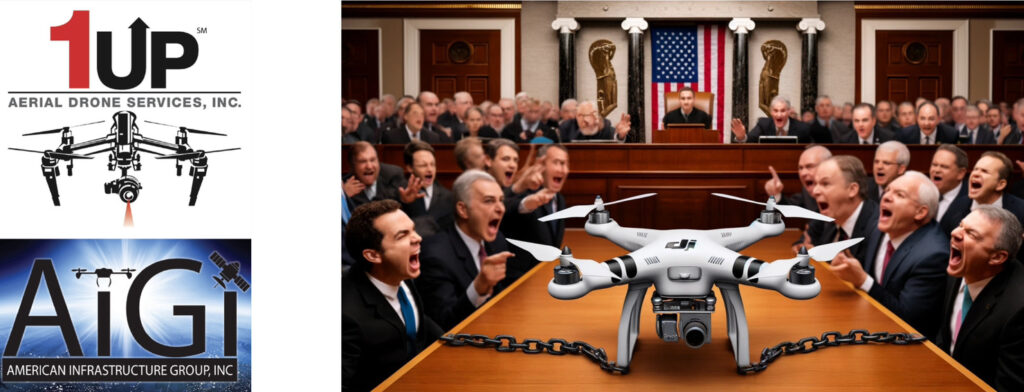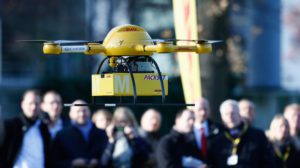The DFR Act:
A Double-Edged Sword for the American Drone Industry
Written by Richard Armstrong – 1UP Drones Software Engineer, June 2024
The Drones for First Responders (DFR) Act, spearheaded by Congresswoman Elise Stefanik, promises to bolster U.S. national security by imposing stringent tariffs on Chinese drones and components. While the legislation aims to promote American-made drones, it simultaneously threatens to destabilize the entire drone ecosystem. Home FPV (First Person View) drone builders, commercial drone pilots, and even American drone manufacturers find themselves caught in the crossfire. Discover how this ambitious act could reshape the drone industry and why its implications extend far beyond first responders.

This article will delve into the intricacies of the DFR Act, highlighting its potential impacts on various stakeholders in the drone industry and exploring the broader economic and technological consequences. Stay tuned to learn more about this controversial legislation and its far-reaching effects.
Key Provisions of the DFR Act
1. Tariffs on Chinese Drones and Components:
-
- The Act imposes an initial 30% tariff on drones and components from China, increasing by 5% annually until 2030. This measure targets Chinese companies, particularly DJI, to reduce their dominance in the U.S. market by making their products more expensive.
- These tariffs are categorized under subheading 8806 in the Harmonized Tariff Schedule, ensuring a structured application based on drone specifications and weights.
2. Ban on Chinese Components:
-
- By 2030, the Act requires that drones imported into the U.S. must not contain any critical components manufactured in China. This ban aims to eliminate potential security risks associated with Chinese-made components in drones.
3. Grant Program:
-
- The revenue from these tariffs is intended to fund a grant program for first responders, critical infrastructure providers, and farmers to purchase secure, American-made drones. This program aims to enhance the competitiveness of U.S. drone manufacturers.
Impact on Home FPV Drone Builders and American Drone Manufacturers
The DFR Act’s ban on Chinese-manufactured components by 2030 significantly impacts home FPV (First Person View) drone builders, American drone manufacturers and even radio control aircraft hobbyists. Many critical drone parts, such as motors, flight controllers, and cameras, are predominantly produced in China. Since American manufacturers do not currently produce these components at competitive prices or with comparable quality, they rely heavily on Chinese imports. The ban would disrupt their supply chains, making it difficult for them to produce drones economically and efficiently.
Economic Impact on Small Drone Businesses and Drone Technology
The tariffs will raise the costs of drones and parts, significantly affecting small businesses that rely on affordable drones for their operations. Commercial drone pilots and small drone businesses, which depend on these affordable drones, will struggle with the increased costs. The absence of competitively priced American alternatives means that many small businesses might not be able to afford the drones necessary to sustain their operations, potentially leading to mass closures of drone companies, and a severe cooling-off of drone technology advancements, driven and funded historically through recreational and commercial end-consumer sales and demand, and not enterprise or government sales.
Market and Economic Consequences
The legislation’s reliance on tariffs to fund first responder programs is seen as unstable. As the tariffs make Chinese drones more expensive and less accessible, sales are likely to decrease, reducing the funds available for the grant program. This dependency on tariff revenue could leave first responder programs underfunded in the future. Moreover, the increased costs and supply chain disruptions could hinder the competitiveness of the American drone market, affecting both manufacturers and end-users.
Legislative Consequences for Users
DJI and other stakeholders argue that the Act would force first responders and other users to purchase less effective and more expensive drones, potentially putting lives at risk. They argue the current U.S. industry is not yet ready to provide drones of comparable quality or features to those produced by DJI, making the transition period challenging for public safety agencies and other users.
Additional Considerations
The DFR Act could eliminate perceived security threats posed by Chinese drones, but it would also increase costs for businesses that rely on affordable DJI drones, leading to a potential collapse of the consumer drone market and a reduction in life-saving operations. Critics argue that the grant program funded by these tariffs creates an inconsistent revenue stream. If DJI drones become too expensive, sales will drop, reducing the available funds for the grant program. Some suggest that direct government investment in American drone companies would be a more stable solution.
Conclusion
While the DFR Act aims to enhance national security and support American drone manufacturers, it inadvertently creates significant challenges for the entire U.S. drone ecosystem. The reliance on Chinese components for both building and operating drones means the legislation’s restrictions would disrupt the market and raise costs. This could ultimately undermine the very industries it seeks to protect and stifle the rapid advancements in drone technology that have greatly benefited all users today.
At 1UP Drones, we understand the ever-changing ecosystem of drone applications. Our state-of-the-art, cutting-edge drone services and products are designed to meet and exceed the specialized and unique needs. With advanced technology and expert knowledge, we ensure your drone operations are not just running but thriving with efficiency, regulatory compliance and safety at the forefront.
Contact us today to discover how our drones and drone services can transform your operations. Let 1UP Drones help you achieve operational excellence in today’s competitive drone landscape. By leveraging specialized drones and drone services equipped for your specific industry, organizations like yours can achieve substantial operational improvements. Make us your trusted drone technology partner — embrace the future today with 1UP Drones.
Visit our website at www.1updrones.com, email info@1updrones.com or give us a call at 972-808-5185. 1UP Drones – Elevating drone operations, one flight at a time! 1UP Drones is a proud subsidiary of American Infrastructure Group, Inc. (AIGI).
References
1. “Stefanik Introduces Bill to Bolster the U.S. Drone Industry.” Congresswoman Elise Stefanik. https://stefanik.house.gov
2. “Drones for First Responders Act.” DRONELIFE.
3. “Republicans-proposed DFR Act would put tariffs on Chinese drones.” The Drone Girl.
4. “Connecticut DJI Drone Ban, DFR, Supreme Court.” DroneXL.
5. DJI responds to price-exploding “Drones for First Responder Act”. DroneDJ.
6. “The U.S. Drone Industry is Under Attack. Again.” The Droning Company.
7. U.S. Harmonized Tariff Schedule – Unmanned Aircraft HS Code 8806. – Flexport


